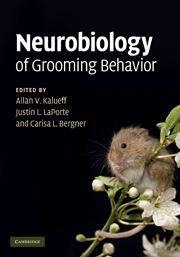Book contents
- Frontmatter
- Contents
- List of contributors
- Preface
- 1 Grooming, sequencing, and beyond: how it all began
- 2 Self-grooming as a form of olfactory communication in meadow voles and prairie voles (Microtus spp.)
- 3 Phenotyping and genetics of rodent grooming and barbering: utility for experimental neuroscience research
- 4 Social play, social grooming, and the regulation of social relationships
- 5 Grooming syntax as a sensitive measure of the effects of subchronic PCP treatment in rats
- 6 Modulatory effects of estrogens on grooming and related behaviors
- 7 Lack of barbering behavior in the phospholipase Cβ1 mutant mouse: a model animal for schizophrenia
- 8 Grooming after cerebellar, basal ganglia, and neocortical lesions
- 9 Striatal implementation of action sequences and more: grooming chains, inhibitory gating, and the relative reward effect
- 10 An ethological analysis of barbering behavior
- 11 Should there be a category: “grooming disorders?”
- 12 Neurobiology of trichotillomania
- Index
- References
7 - Lack of barbering behavior in the phospholipase Cβ1 mutant mouse: a model animal for schizophrenia
Published online by Cambridge University Press: 04 August 2010
- Frontmatter
- Contents
- List of contributors
- Preface
- 1 Grooming, sequencing, and beyond: how it all began
- 2 Self-grooming as a form of olfactory communication in meadow voles and prairie voles (Microtus spp.)
- 3 Phenotyping and genetics of rodent grooming and barbering: utility for experimental neuroscience research
- 4 Social play, social grooming, and the regulation of social relationships
- 5 Grooming syntax as a sensitive measure of the effects of subchronic PCP treatment in rats
- 6 Modulatory effects of estrogens on grooming and related behaviors
- 7 Lack of barbering behavior in the phospholipase Cβ1 mutant mouse: a model animal for schizophrenia
- 8 Grooming after cerebellar, basal ganglia, and neocortical lesions
- 9 Striatal implementation of action sequences and more: grooming chains, inhibitory gating, and the relative reward effect
- 10 An ethological analysis of barbering behavior
- 11 Should there be a category: “grooming disorders?”
- 12 Neurobiology of trichotillomania
- Index
- References
Summary
Summary
Abnormal phospholipid metabolism has been implicated in the pathogenesis of schizophrenia, and phospholipase C (PLC) β1 was shown to be reduced in specific brain areas of patients with schizophrenia. However, the causal relationship of the PLCβ1 gene with the behavioral symptoms of schizophrenia remains unclear. Recent studies with the knockout (KO) mice for the PLCβ1 gene have revealed an array of interesting phenotypes, which along with other previous information makes the PLCβ1-KO mouse a good candidate for an animal model for schizophrenia. This also suggests that the PLCβ1-linked signaling pathways may be involved in the neural system whose function is disrupted in the pathogenesis of schizophrenia. In this chapter we will introduce various studies relevant to this issue, highlighting the social withdrawal phenotypes of the mutant, such as the lack of barbering behaviors.
Introduction
An animal model for a disease is expected to display endophenotypes, which are quantifiable phenotypes relevant to symptoms of the disease to be modeled (Braff and Freedman 2002; Gould and Gottesman 2006; van den Buuse et al. 2005). The endophenotypes currently pursued in schizophrenia models are: locomotive hyperactivity, sensorimotor gating deficit, deficits in social interaction, and cognitive deficits (e.g., learning and memory). Genetically modified mice targeted on candidate susceptibility genes have so far been generated as animal models for schizophrenia.
- Type
- Chapter
- Information
- Neurobiology of Grooming Behavior , pp. 131 - 144Publisher: Cambridge University PressPrint publication year: 2010



